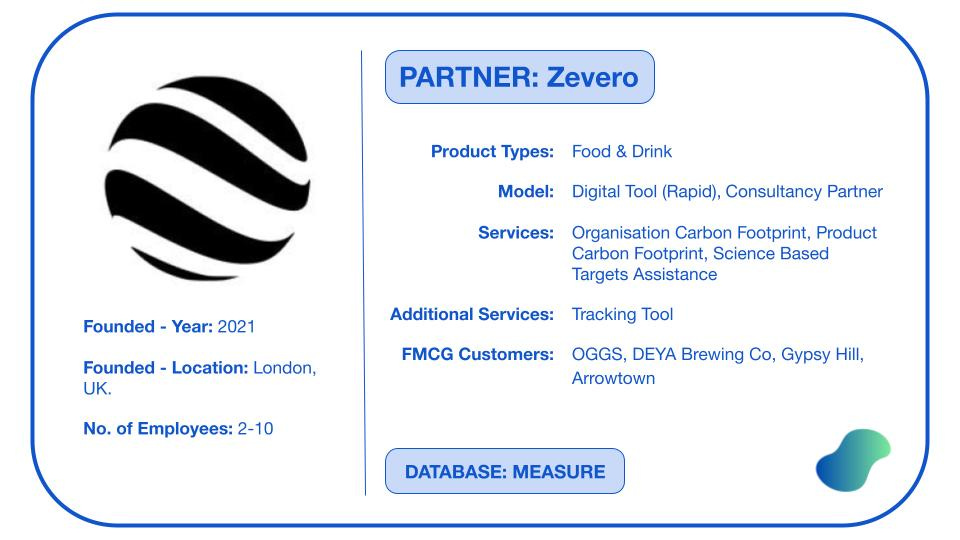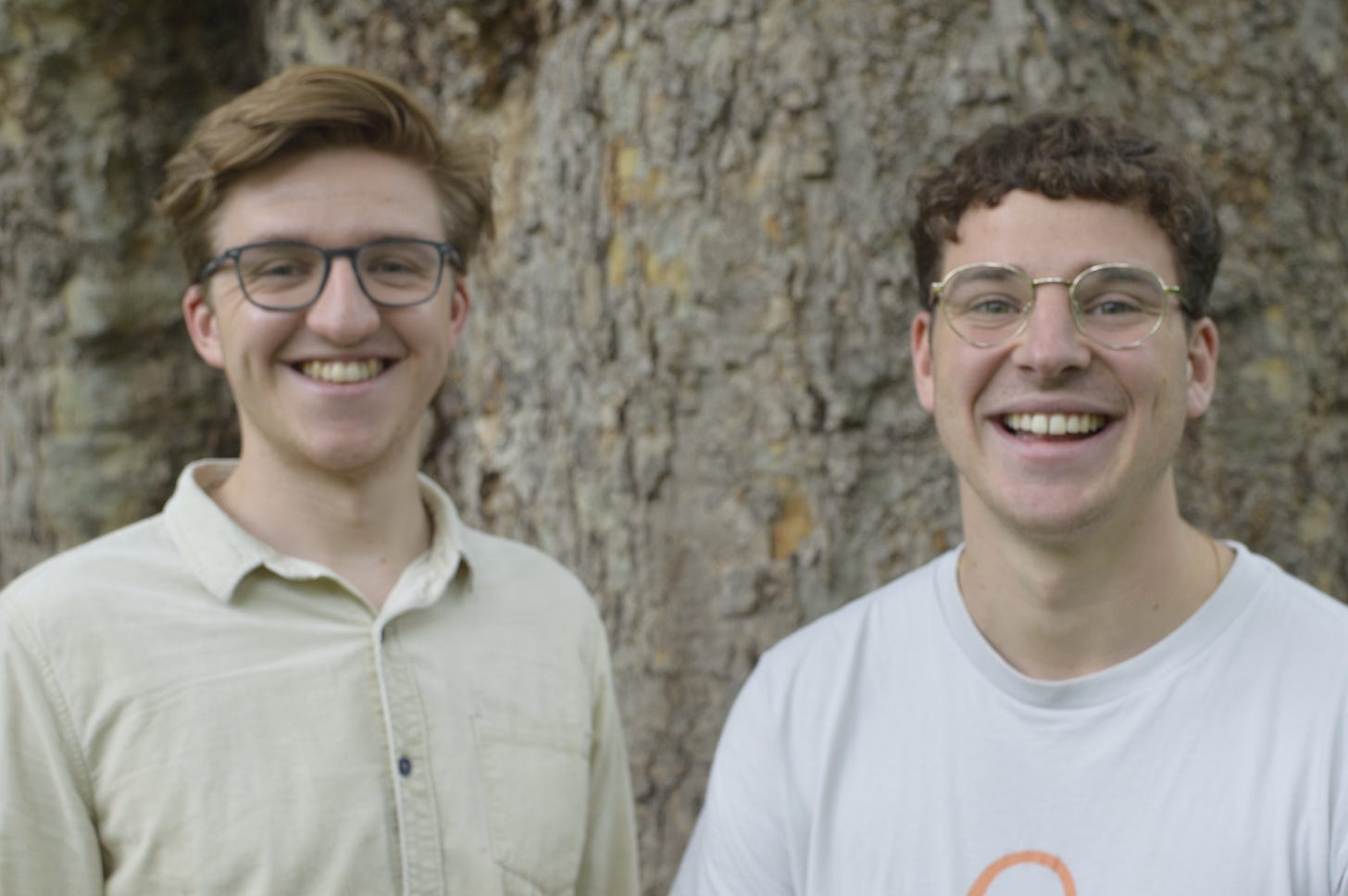🤝#3 - Meet the Partners: Zevero
MEASURE DATABASE - Featuring George Wade, Co-Founder and COO
Our ‘Meet the Partners’ series interviews the experts helping consumer goods businesses around the world get a handle on their heat. Each interview aims to provide you with insight into their work, what you can expect from partnering with them, and tips to help your business thrive.
A decade ago, corporate carbon accounting was far from the norm. Today, we’re living in a different world. With the effects of climate change becoming increasingly clear, customers are demanding action, and so are investors. It can be a tough ask for businesses, especially those with limited resources, to meet these demands. Internal teams are unlikely to contain the relevant expertise needed, so finding a carbon accounting partner is a big and often essential first step.
Our Meet the Partners series interviews the experts helping consumer goods businesses around the world get a handle on their heat. Each interview will provide you with insight into what makes them different, a glimpse into their work, and tips to help your business thrive.
This week, we're featuring a company on our MEASURE Database - Zevero

Zevero is a decarbonisation platform to help companies measure, report on and most importantly reduce their emissions.
Zevero’s Mission?
Build the tools and resources companies need to make carbon emissions a core KPI alongside revenue, customers and costs.
We caught up with George Wade, co-founder, to get to grips with how Zevero can help businesses, and how businesses can help themselves.
We’d love to have an overview of what Zevero offers...
👉 First thing’s first, how does Zevero support consumer goods companies in their climate journey?
We begin with a kick off meeting with the key goal of understanding what each company wants to gain from working with us and what the end result they’re looking for. We then take care of everything from the data collection to the climate strategy, working alongside their team to make sure everything is clear and well understood.
Our primary focus is on corporate carbon footprints but we have also worked with a number of companies to map their product carbon footprint.
We’ve worked with everyone from companies that just don’t know where to start, all the way to those who have already started the process but see the value in using our platform and support to make climate action easier.
Our ultimate goal is to reduce the emissions of every company we work with as well as empowering and educating their team about climate action.
👉 Do you have a specialist focus? What makes you different from other carbon accounting offerings?
Our specialist focus is on the drinks industry, primarily we work with a lot of craft brewing companies like DEYA and Gipsy Hill. Breweries make great clients, tasty ones, that’s for sure.
I’d say where we separate ourselves is our detailed approach to collecting data on supply chain emissions. We see ourselves as a decarbonisation platform, not just a tick box accounting software. So if a company is interested in taking climate action with the power of software and consultants to help them reduce emissions, we’re the right people to speak to.
👉 How much do your services cost?
While the cost varies from company to company, we are typically looking at £4k upwards. Typically, it depends on the number of employees, facilities and the scope of work. Fees do include backdated emissions, our platform for 12 months and unlimited support for decarbonisation and communication, so it’s always great value. You can find more on our website.
👉 How long does a typical project take with you? Are there any examples of projects you can give?
Typically, we’ll go from signing a contract to finalising the first year emissions in 4-6 weeks, but this can vary. The quickest turnaround we’ve had from signing a contract to having a report and finalised emissions is just over a week, but that was a simple services company.
Other projects that are more extensive and detailed could be 2-3 months. That often includes product footprinting or lifecycle assessments, for example our work at DEYA Brewing.
👉 Can you give more detail on the additional services you provide?
Reducing emissions is really about the engagement of a whole business. Alongside our software, we do talks, workshops and site visits which are always great fun. For those who are not within a train or cycle ride, we’ll run online talks and workshops for clients helping them understand carbon accounting and climate change.
In addition, we created a ‘Climate Hub’ with resources on demand to help companies understand carbon emissions and how to reduce them.
Whatever a company needs to accelerate climate action, appease stakeholders or provide more information for customers, we’re always on hand to help.
Let’s dig into the details...
👉 If a smaller business came to you with a relatively vague goal ('we want to make our business more sustainable') and a tight budget, how could you help them?
I think the first step would be to understand what their budget is and whether they should be spending the money to map their footprint, or instead use that for action.
Let’s take a drinks brand for example, we’d be able to identify the key breakdowns in their emissions quite quickly. I’d suggest that they start small, make sure all their packaging is recyclable at home, is recycled where possible and ensure that they know where they’re buying everything from.
There are so many ways to start being sustainable, and without talking ourselves out of work, for a number of smaller companies, spending a couple of thousand to measure your emissions but then having no budget to reduce them doesn’t make sense. Our core focus is on making decarbonisation possible, our tool and our experts make that possible.
We’re always happy to help with smaller projects and lower fees and we’ve also got a list of everything you should be doing, let us know if you’d like a copy!
👉 Our MEASURE database aims to help companies take the crucial first step of measuring their emissions. When a brand comes to you with the goal of measuring their emissions, what are your first steps?
From the beginning, we start to understand where a customer is on their journey but as a typical rule of thumb, the process looks like this:
Meet the team and explain the process with a training session and workshop.
Start collecting carbon data. This is not as complex as you might think, 90% of the data will be with your e-commerce provider and accounting software.
Start mapping your emissions and building out your dashboard on our platform.
Get a clear picture of where your emissions come from and identify reductions.
After the initial measurement, we start to automate the process of monitoring your emissions. Our platform is built to help you reduce your emissions, we’ll work with you to help implement your climate programme. It’s the most important part after all.
Is that just as applicable to large and small brands?
The process for larger brands is more or less the same. There are often more hurdles to jump through, more complexity and more stakeholders, but the initial process of discovery, data and education is just the same. Starting the process of measuring your emissions as a small or large brand is empowering and at this point it’s something you can’t afford to ignore.
👉 Can you give an example of a consumer goods brand that you’ve worked with, and any further details on that project?
We can look at DEYA, they’re a great case study for a smaller company looking ahead and realising that as they grow, they’ll need to reduce their impact. Initially, we worked with DEYA in 2020 to start their journey into sustainability, since then, they’ve put a carbon label on over 5 million cans of great beer, worked with their suppliers to better understand their impact and find ways to collaborate to reduce their emissions. They’re also measuring their emissions on a monthly basis using our platform, which is fantastic for us and for them.
Not only has it driven change within the company, creating a culture employees are proud of, but it's also led to conversations with their customers and improved their relationship with their beer drinkers. It feels great knowing that the money they spend working with us can actually lead to lower impact and a stronger business. A climate and small business win!
Now for some advice…
👉 What common misconceptions do consumer goods brands have before they start measuring their emissions? Are there any common surprises?
I’d say a lot has changed over the last few years. People have become really well educated on sustainability, often questioning data and ideas to avoid pitfalls of greenwashing. However, I would say a more common misconception is that they underestimate the fact that 80% of emissions will come from supply chains.
Perhaps people also think that calculating emissions and taking impact is harder than it needs to be. With a good partner, it’s a fairly simple process that can be integrated into your everyday business. That’s what we find with our product at least.
👉 What areas of becoming more sustainable are particularly tricky for smaller consumer goods businesses?
For small consumer goods businesses it can be a little harder because there is a limit to what is controlled and influenced by them. For example, if you’re in a shared office, you have no control over what tariff you’re on or whether your building is energy efficient. Similarly, it’s not that easy to tell a major packaging provider to reduce their emissions.
However, being small has advantages, you’re nimble and you can make changes much easier than larger brands. Use change to your advantage, there are so many suppliers doing great things that you can work with, often at a very similar price point.
👉 What are a few simple steps that any organisation can do to reduce their impact?
Starting small is possible. I’d suggest that if you’re a consumer goods company, under a product footprint, anywhere from 25-50% of your emissions will be from packaging. Make sure you have great coverage on where all of your materials come from and opt for sustainably sourced products and ones that are at home recyclable for consumers.
Other steps include making sure any offices, warehouse or manufacturing facilities that you control are using renewable energy, that’s often a simple switch that could save you money. Most serviced offices also use renewable energy now, so always make that part of your plans when you grow.
The key thing going forward should be to start understanding your entire impact. That way you can identify hotspots of where you can cut emissions. That’s where the fun begins!
👉 Any final thoughts, or words of advice for brands?
Get started now before it’s too late. I know the people that read Following The Footprints already care about climate, but if your team or your employers are not already setting targets and working to take action you should make it a key goal going into 2023.
We’re always happy to help, give free advice or generally be a part of a great community, so reach out if you’d like some help!
What next?
👉 Check out Zevero’s website, LinkedIn and Twitter.
👉 Looking for a MEASURE partner? Reach out to the Zevero team to explore working with them!




